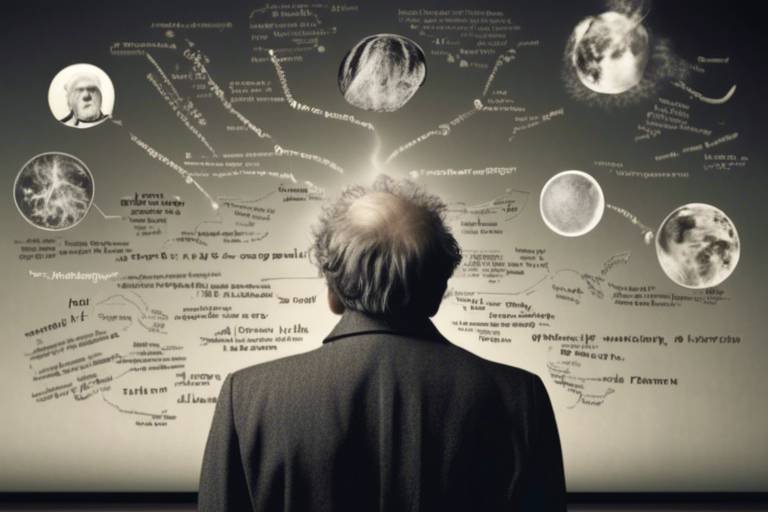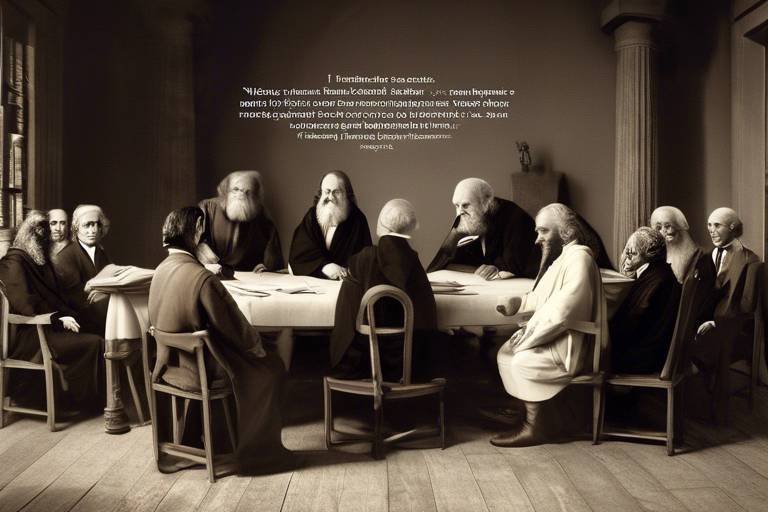Psychophysics and its Philosophical Foundations
Welcome to the fascinating world of psychophysics, where the realms of science and philosophy intertwine to explore the very essence of human perception and cognition. This field delves into the intricate relationship between sensory experiences and the physical stimuli that elicit them. Imagine standing in a bustling café, the aroma of freshly brewed coffee wafting through the air, while your ears pick up the soft chatter of conversations around you. How do these sensory inputs shape your experience? Psychophysics seeks to answer such questions by quantifying how we perceive the world around us.
At its core, psychophysics provides a framework for understanding how we interpret sensory information. It’s like having a map that guides us through the complex landscape of our senses. By analyzing the thresholds of perception and the scaling of sensory inputs, researchers can uncover the hidden patterns that govern our interactions with the environment. This article will explore the historical context of psychophysics, key concepts that underpin the field, and the philosophical implications that arise from our understanding of perception.
As we journey through this exploration, we will encounter pioneering figures such as Gustav Fechner and Ernst Weber, whose groundbreaking work laid the foundation for modern psychophysics. Their experiments not only advanced our understanding of sensory perception but also opened the door to philosophical inquiries about the nature of reality and consciousness. So, fasten your seatbelt as we embark on this exciting adventure through the intricate connections between psychophysics and philosophy!

Historical Background of Psychophysics
This article explores the relationship between psychophysics and philosophy, examining key concepts, historical context, and implications for understanding human perception and cognition.
The origins of psychophysics can be traced back to the 19th century, a period marked by a surge of interest in understanding how humans perceive the world around them. Pioneers like Gustav Fechner and Ernst Heinrich Weber emerged as key figures in this groundbreaking field, laying the foundational groundwork that would shape our understanding of sensory perception through experimental methods. Their work was revolutionary, as it bridged the gap between the subjective experience of perception and the objective measurement of stimuli.
Fechner, often considered the father of psychophysics, introduced a systematic approach to studying the relationship between physical stimuli and their corresponding sensory experiences. He developed a series of experiments that quantified how changes in stimulus intensity affect perception. For example, he explored how much brighter a light must be for a person to notice a difference, which is now known as the just noticeable difference (JND).
Weber, on the other hand, contributed significantly to the field by formulating what is now known as Weber's Law. This principle states that the ratio of the increment threshold to the background intensity is a constant. In simpler terms, it means that our ability to perceive changes in stimuli is proportional to the intensity of the original stimulus. This relationship laid the groundwork for further exploration into how humans interpret sensory information.
To illustrate the historical context of psychophysics, consider the following table that highlights key milestones:
| Year | Milestone | Contributors |
|---|---|---|
| 1860 | Publication of "Elements of Psychophysics" | Gustav Fechner |
| 1834 | Formulation of Weber's Law | Ernst Heinrich Weber |
| 1879 | Establishment of the first psychology laboratory | Wilhelm Wundt |
This table encapsulates the significant contributions that shaped the early landscape of psychophysics. As these ideas began to take root, they sparked a wave of interest that transcended the realm of psychology, influencing various fields such as neuroscience, philosophy, and even art. The exploration of how humans perceive and interpret sensory information opened up new avenues for understanding the complexities of the human mind.
Moreover, the historical development of psychophysics was not just about individual contributions but also about the collaborative nature of scientific inquiry. Researchers began to realize that understanding human perception required a multidisciplinary approach, combining insights from psychology, philosophy, and even physics. This collaborative spirit laid the groundwork for modern cognitive science, where the interplay between perception and cognition continues to be a focal point of research.
In summary, the historical background of psychophysics is rich and dynamic, characterized by the pioneering efforts of individuals like Fechner and Weber. Their foundational principles not only shaped the field of psychology but also challenged our understanding of how we perceive the world. As we delve deeper into the implications of psychophysics, it becomes clear that this field has profound philosophical ramifications, prompting us to question the nature of reality, perception, and consciousness itself.
- What is psychophysics? Psychophysics is the branch of psychology that deals with the relationship between physical stimuli and the sensations and perceptions they produce.
- Who are the key figures in psychophysics? The key figures include Gustav Fechner and Ernst Heinrich Weber, who laid the foundational principles of the field in the 19th century.
- What is the Weber-Fechner Law? The Weber-Fechner Law describes how the perceived intensity of a stimulus relates to its physical intensity, establishing a foundational principle in sensory psychology.

Key Concepts in Psychophysics
Psychophysics is a fascinating field that delves into the intricate relationship between physical stimuli and the sensations they evoke in our minds. To truly grasp this discipline, it's essential to understand several key concepts that form its foundation. One of the most critical ideas is the concept of thresholds. These thresholds represent the minimum intensity of a stimulus required for it to be perceived. Imagine walking into a dark room; at first, you can barely see anything, but as your eyes adjust, you start to notice shapes and colors. This adjustment illustrates the concept of absolute threshold, which is the lowest level of stimulus that can be detected 50% of the time.
Another vital aspect is scaling, which refers to how we quantify our perceptions. The Stevens' Power Law is a prominent example that suggests our perception of stimuli is not linear. Instead, it operates on a logarithmic scale, meaning that as the intensity of a stimulus increases, our perception of that increase becomes less pronounced. For instance, if you were to increase the volume of music, the difference between 30 and 40 decibels might feel more significant than the difference between 90 and 100 decibels, even though the actual change is the same. This non-linear relationship is crucial for understanding how we experience the world around us.
Additionally, sensory discrimination plays a pivotal role in psychophysics. This concept refers to our ability to differentiate between different stimuli. Have you ever tried to identify a song played at a low volume in a noisy environment? That’s your sensory discrimination at work! It is often measured using the just noticeable difference (JND), which indicates the smallest change in stimulus intensity that can be detected. The JND varies depending on the initial intensity of the stimulus, further illustrating the complexities of our sensory systems.
To summarize these key concepts, let's take a look at the following table:
| Concept | Description |
|---|---|
| Thresholds | The minimum intensity of a stimulus required for detection. |
| Scaling | Quantifying perceptions, often non-linear in nature. |
| Sensory Discrimination | The ability to distinguish between different stimuli. |
Understanding these concepts not only enriches our knowledge of psychophysics but also has practical implications. For example, marketers utilize these principles to design advertisements that effectively grab attention and influence consumer behavior. By knowing how thresholds and sensory discrimination work, they can create more compelling content that resonates with their audience.
In conclusion, the key concepts of psychophysics—thresholds, scaling, and sensory discrimination—provide a robust framework for exploring how we perceive and interpret the world around us. These ideas are not just academic; they are deeply embedded in our everyday experiences, shaping how we interact with our environment and each other.
- What is psychophysics? Psychophysics is the study of the relationship between physical stimuli and the sensations and perceptions they produce.
- Who are the key figures in psychophysics? Notable figures include Gustav Fechner and Ernst Heinrich Weber, who laid the groundwork for this field in the 19th century.
- How does the Weber-Fechner Law apply in real life? This law helps us understand how we perceive changes in stimulus intensity, which is crucial in fields like marketing and product design.

Weber-Fechner Law
The is a cornerstone of psychophysics, elegantly illustrating how we perceive changes in stimuli. To put it simply, this law states that the perceived change in a stimulus is proportional to the original intensity of that stimulus. Imagine holding a small weight in one hand and a larger weight in the other; the difference in weight you can perceive will depend on how heavy the original weights are. This principle is not just a theoretical concept; it has profound implications across various domains, from psychology to marketing.
At its core, the Weber-Fechner Law can be broken down into two essential components: the Weber's Law and the Fechner's Law. Weber's Law posits that the smallest detectable difference in stimulus intensity, known as the just noticeable difference (JND), is a constant proportion of the original stimulus. For instance, if you are in a dimly lit room and someone turns on a small flashlight, you might notice it immediately. However, if you are in broad daylight, that same flashlight may go unnoticed. This variability is captured by the ratio of the JND to the original stimulus intensity.
Fechner took Weber's findings further by suggesting that the relationship between stimulus intensity and perceived intensity is logarithmic. This means that as the intensity of a stimulus increases, the perceived intensity increases at a slower rate. For example, doubling the brightness of a light does not necessarily result in a perception of double the brightness. Instead, our sensory systems adapt, leading to a more nuanced understanding of our environment.
| Aspect | Weber's Law | Fechner's Law |
|---|---|---|
| Definition | Proportional relationship between stimulus and JND | Logarithmic relationship between stimulus intensity and perception |
| Formula | ΔI/I k | S k log(I) |
| Application | Understanding sensory thresholds | Quantifying perception across different stimuli |
This law has significant implications in various fields, including marketing and design. For example, when designing a product, understanding how consumers perceive changes in size, color, or sound can greatly enhance user experience. Marketers also utilize this law to create more effective advertisements by ensuring that changes in their messaging or visuals are noticeable enough to capture attention without overwhelming the viewer.
However, it's essential to acknowledge the limitations of the Weber-Fechner Law. While it provides a useful framework for understanding basic sensory perception, it can fall short when dealing with complex stimuli or when individual differences come into play. For instance, the law may not apply equally to all sensory modalities or to all individuals, leading researchers to explore alternative models of perception that account for these variations. This ongoing exploration is crucial for a deeper understanding of human cognition and perception.

Application of the Law
The Weber-Fechner Law is not just a theoretical construct; it has profound implications in various fields that touch our daily lives. By understanding how we perceive changes in stimuli, businesses and designers can tailor their products and marketing strategies to better resonate with consumers. For instance, when companies launch new products, they often rely on principles derived from this law to ensure that the changes made are noticeable yet not overwhelming. Imagine walking into a store and seeing a new product that subtly stands out from the others; this is the art of applying psychophysical principles in marketing.
In marketing, the Weber-Fechner Law informs how brands can optimize their advertising efforts. By adjusting the intensity of their messages—be it through visual elements, sounds, or even the choice of words—they can create a more engaging experience for potential customers. For example, a slight increase in the brightness of a product's packaging can make it more appealing without being jarring. Such subtle changes can lead to increased sales and a stronger brand presence in a competitive market.
Moreover, the application extends beyond marketing into the realm of design. User interface (UI) and user experience (UX) designers utilize these principles to create intuitive and accessible digital environments. By understanding how users perceive different elements on a screen, designers can manipulate sizes, colors, and placements to enhance usability. For instance, if a button is too small or blends too much with the background, it might go unnoticed, leading to frustration. However, by applying the Weber-Fechner Law, designers can ensure that buttons are sized and colored in a way that they stand out just enough to catch the user’s attention without overwhelming them.
In addition to marketing and design, the law has implications in fields like education and healthcare. Educators can apply these principles to develop teaching materials that effectively capture students' attention and enhance learning. Similarly, in healthcare, understanding patient perception can improve communication strategies between healthcare providers and patients, leading to better health outcomes.
In summary, the Weber-Fechner Law serves as a bridge between theoretical psychology and practical application across various sectors. Its insights into human perception enable businesses and designers to create more effective and user-friendly experiences. By leveraging these principles, they can not only meet but exceed consumer expectations, ultimately leading to greater satisfaction and loyalty.
- What is the Weber-Fechner Law?
The Weber-Fechner Law explains the relationship between the physical intensity of a stimulus and its perceived intensity, suggesting that perception is logarithmic rather than linear.
- How does the Weber-Fechner Law apply in marketing?
Marketers use this law to create advertisements that are noticeable yet not overwhelming, enhancing consumer engagement and brand recognition.
- Can the Weber-Fechner Law be applied to digital design?
Absolutely! UI/UX designers utilize the principles of this law to optimize the visibility and usability of digital interfaces, ensuring that important elements stand out.
- Are there limitations to the Weber-Fechner Law?
Yes, the law tends to fall short when dealing with complex stimuli or in cases where subjective experience varies greatly between individuals.

Limitations of the Law
While the Weber-Fechner Law has been a cornerstone in the field of psychophysics, it is not without its limitations. One of the most significant drawbacks is its applicability primarily to simple stimuli. When we encounter complex stimuli—like a rich symphony of sounds or a vibrant painting—the law tends to falter. This is because the perception of intensity becomes less straightforward when multiple elements interact. Imagine trying to quantify the beauty of a sunset; the interplay of colors, light, and shadows creates a sensory experience that can't easily be distilled into a single measure of intensity.
Moreover, the Weber-Fechner Law assumes a linear relationship between stimulus intensity and perceived intensity. However, this linearity often breaks down in real-world situations. For instance, consider how we perceive loud sounds. A sound that is twice as loud is not necessarily perceived as twice as intense. This discrepancy highlights the complexity of human perception and suggests that other factors, such as context and individual differences, play a crucial role.
Another limitation arises when considering individual differences in sensory perception. Factors such as age, cultural background, and personal experiences can significantly influence how stimuli are perceived. For example, what might be perceived as a faint sound by one person could be a loud noise to another. This variability challenges the universality of the Weber-Fechner Law, indicating that a one-size-fits-all approach may not be effective in understanding human perception.
To better illustrate these limitations, let’s take a look at the following table, which summarizes the key challenges associated with the Weber-Fechner Law:
| Limitation | Description |
|---|---|
| Complex Stimuli | The law struggles to account for the perception of complex stimuli, where multiple sensory inputs interact. |
| Non-linear Relationships | Assumes a linear relationship that may not hold true in practical scenarios, especially with varying intensities. |
| Individual Differences | Variations in perception based on personal experiences and backgrounds can lead to inconsistent application of the law. |
In light of these limitations, researchers have turned to alternative models and theories to further explore the nuances of perception. For instance, Signal Detection Theory offers a more comprehensive framework by considering the decision-making processes involved in perception, especially in uncertain conditions. By acknowledging the complexities of human perception, we can better understand the intricate ways in which we interact with the world around us.
- What is the Weber-Fechner Law? The Weber-Fechner Law describes the relationship between the physical intensity of a stimulus and its perceived intensity, suggesting that perception does not increase linearly with stimulus intensity.
- Why are there limitations to the Weber-Fechner Law? Its limitations arise from its focus on simple stimuli, assumptions of linearity, and the variability in individual sensory perception.
- What is an alternative to the Weber-Fechner Law? Signal Detection Theory is one alternative, expanding on psychophysical principles to incorporate decision-making processes in perception.

Signal Detection Theory
Signal Detection Theory (SDT) is a fascinating framework that dives deep into the complexities of how we perceive signals in the midst of noise. Imagine you're at a crowded party, trying to hear your friend calling your name over the chatter and music. That’s essentially what SDT addresses: how we make decisions about whether a signal is present or absent in a noisy environment. This theory goes beyond just understanding our sensory perceptions; it also incorporates the cognitive processes involved in decision-making. It’s like being a detective, where you have to sift through clues (or signals) while ignoring distractions (the noise) to solve a mystery.
At its core, SDT introduces several key concepts that help us understand this process. One of the main ideas is the distinction between sensitivity and criterion. Sensitivity refers to our ability to detect a signal when it is present, while the criterion is the threshold we set for deciding whether a signal is present or not. Think of it as tuning a radio: if your sensitivity is high, you can pick up faint signals; but if your criterion is too strict, you might miss out on important information. This balance is crucial in various real-world situations, from medical diagnostics to security screenings.
To illustrate this, let's consider a simple table that summarizes the four possible outcomes in a signal detection scenario:
| Outcome | Signal Present | Signal Absent |
|---|---|---|
| Response Present | Hit | False Alarm |
| Response Absent | Miss | Correct Rejection |
This table highlights the four possible outcomes of a signal detection task: Hits (correctly identifying the presence of a signal), False Alarms (incorrectly identifying a signal when there isn't one), Misses (failing to identify a signal that is present), and Correct Rejections (correctly identifying when no signal is present). Each of these outcomes provides valuable insight into our perceptual abilities and decision-making processes.
Moreover, SDT has practical applications across various fields. In psychology, it helps researchers understand how different factors, such as attention and motivation, influence our perceptual judgments. In marketing, businesses utilize SDT principles to design advertisements that effectively capture consumer attention amidst a sea of competing messages. Even in medical diagnostics, understanding how to minimize false alarms can lead to better patient outcomes and more accurate diagnoses.
In conclusion, Signal Detection Theory is a powerful tool for unraveling the intricacies of human perception. It not only sheds light on how we detect signals in a noisy world but also emphasizes the cognitive processes that underpin our decisions. By appreciating the balance between sensitivity and criterion, we can better understand our perceptual experiences and improve our decision-making in everyday life.
- What is Signal Detection Theory? Signal Detection Theory is a framework that explains how we detect signals in the presence of noise and involves understanding sensitivity and decision criteria.
- How does SDT apply to real-life situations? SDT is applicable in various fields such as psychology, marketing, and medical diagnostics, helping to improve decision-making and perceptual accuracy.
- What are the key outcomes in Signal Detection Theory? The key outcomes include hits, false alarms, misses, and correct rejections, which help in evaluating our perceptual abilities.

Philosophical Implications of Psychophysics
When we delve into the , we uncover a rich tapestry of questions about the very nature of reality, perception, and consciousness. It's like peeling back the layers of an onion—each layer reveals deeper insights into how we understand our world. At the heart of this exploration is the inquiry into how our sensory experiences shape our understanding of reality. Are we merely passive observers of the world around us, or do our minds actively construct our perceptions based on the stimuli we encounter?
One of the most compelling discussions that arises from this intersection of psychophysics and philosophy is the mind-body problem. This age-old debate revolves around the relationship between mental states—like thoughts, feelings, and perceptions—and physical processes in the brain. Psychophysics provides empirical data that can inform this philosophical discourse. For instance, when we experience a change in sensory input, such as a shift in light or sound, how does that translate into our mental experience? Does our brain merely respond to stimuli, or is there a more complex interplay between our physical and mental states?
Moreover, the concept of phenomenology plays a crucial role in understanding perception. Phenomenology emphasizes the subjective experience of individuals and how they interpret sensory information based on their lived experiences. Imagine walking through a bustling market: the vibrant colors, the cacophony of sounds, and the tantalizing aromas all converge to create a rich sensory tapestry. Each person's interpretation of this experience is unique, shaped by their past experiences, emotions, and even cultural background. Thus, psychophysics, while grounded in empirical measurement, must also account for these subjective interpretations to fully grasp the complexities of perception.
To illustrate the philosophical implications further, consider the following table that summarizes key philosophical questions raised by psychophysics:
| Philosophical Question | Implication |
|---|---|
| What is the nature of reality? | Explores how sensory information shapes our understanding of the world. |
| How do mental states relate to physical processes? | Investigates the mind-body connection through empirical data from psychophysics. |
| What role does subjective experience play in perception? | Highlights the importance of individual interpretation in understanding sensory information. |
As we navigate these philosophical waters, it's essential to recognize that psychophysics does not provide all the answers. Instead, it opens the door to a myriad of questions that challenge our understanding of ourselves and the world around us. The implications of these inquiries are profound, influencing fields as diverse as psychology, neuroscience, and even artificial intelligence.
In conclusion, the philosophical implications of psychophysics compel us to reflect on our own experiences and perceptions. They remind us that while we may strive for objective understanding, our subjective experiences are equally valid and essential in shaping our reality. So, the next time you perceive something—be it a sound, a sight, or a smell—consider the intricate dance between your senses and your mind. How does that moment reflect your unique experience of the world?
- What is psychophysics?
Psychophysics is the branch of psychology that studies the relationship between physical stimuli and the sensations and perceptions they produce.
- How does psychophysics relate to philosophy?
Psychophysics raises philosophical questions about the nature of reality, perception, and consciousness, exploring how sensory experiences shape our understanding of the world.
- What is the mind-body problem?
The mind-body problem is a philosophical debate concerning the relationship between mental states and physical processes, with psychophysics providing empirical insights into this relationship.
- What is phenomenology?
Phenomenology is a philosophical approach that focuses on individuals' subjective experiences and how they interpret sensory information based on their lived experiences.

Mind-Body Problem
The has puzzled philosophers, scientists, and curious minds for centuries. At its core, this philosophical dilemma grapples with the relationship between our mental states—thoughts, feelings, and consciousness—and the physical processes of our bodies. Imagine your mind as a vibrant orchestra, filled with melodies of thoughts and emotions, while your body serves as the stage where this performance takes place. But how do these two seemingly distinct entities communicate? Are they merely two sides of the same coin, or do they exist in separate realms? This is the crux of the mind-body problem.
Historically, several theories have emerged to tackle this intricate relationship. For instance, dualism, famously advocated by René Descartes, posits that the mind and body are fundamentally different substances. In contrast, monism suggests that everything, including mental phenomena, is part of a single substance. This leads us to ponder: if the mind is merely a product of brain activity, can our thoughts truly exist independently of our physical being? Or, if they are separate, how do they interact? This interaction is where psychophysics steps in, providing empirical data that can illuminate aspects of this complex debate.
Psychophysics explores how our sensory experiences relate to physical stimuli, offering insights into how we perceive reality. For example, when we feel joy or sadness, what physical changes occur in our bodies? Our heart rate may increase, or we might experience a rush of adrenaline. Such physiological responses indicate a profound connection between our mental states and bodily reactions. This interplay raises further questions about consciousness: Is our awareness of these sensations merely an illusion, or do they reflect a deeper reality?
To better understand this relationship, consider the following key points:
- Empirical Evidence: Psychophysics provides data that can help bridge the gap between mental experiences and physical processes.
- Consciousness: The mind-body problem invites us to explore the nature of consciousness itself. What does it mean to be aware?
- Subjective Experience: Each individual's experience of reality is unique, raising questions about the universality of perception.
As we delve deeper into the mind-body problem, we must also consider the implications of psychophysical findings on our understanding of consciousness. For example, if our sensory perceptions can be quantified and measured, does that diminish the richness of our subjective experiences? Or does it empower us to appreciate the complexity of our existence? This ongoing dialogue between psychophysics and philosophy not only enriches our understanding of human perception but also challenges us to confront the very nature of reality itself.
In conclusion, the mind-body problem remains a fascinating frontier for exploration. As we continue to unravel the mysteries of how our thoughts and feelings intersect with our physical selves, we gain valuable insights into what it means to be human. The journey is far from over, and with each discovery, we inch closer to understanding the profound connection between our minds and bodies.
- What is the mind-body problem? The mind-body problem is a philosophical question regarding the relationship between mental states and physical processes.
- How does psychophysics relate to the mind-body problem? Psychophysics studies the relationship between stimuli and perception, providing empirical data that can inform the mind-body debate.
- What are the main theories addressing the mind-body problem? Key theories include dualism, which posits that mind and body are separate, and monism, which suggests they are one substance.
- Why is understanding the mind-body relationship important? It helps us explore the nature of consciousness and the subjective experiences that shape our understanding of reality.

Phenomenology and Perception
When we delve into the fascinating world of phenomenology, we find ourselves exploring not just the mechanics of perception, but the very essence of how we experience the world around us. Imagine walking through a bustling market, the vibrant colors of fruits and vegetables catching your eye, the rich aromas of spices filling the air, and the cacophony of voices blending into a symphony of life. In this moment, you are not merely a passive observer; you are an active participant in a sensory dance, where each perception shapes your understanding of reality.
Phenomenology emphasizes the subjective experience of perception, arguing that every individual interprets sensory information through the lens of their own lived experiences. This perspective is crucial because it acknowledges that two people can perceive the same stimulus in vastly different ways. For instance, consider how a piece of music can evoke joy in one person while stirring feelings of nostalgia in another. This variability highlights the importance of context, emotion, and personal history in shaping our perceptions.
Furthermore, phenomenology encourages us to ask critical questions about the nature of consciousness. What does it mean to truly "see" something? Is perception merely a passive reception of stimuli, or is it an active construction of reality? These inquiries push us to consider the relationship between our sensory experiences and our understanding of existence itself. The phenomenological approach suggests that to grasp the essence of perception, we must delve into the first-person perspective, emphasizing how individuals experience and interpret their surroundings.
To better understand the implications of phenomenology on perception, we can explore some fundamental concepts:
- Intentionality: This principle posits that consciousness is always directed towards something. Every perception is an engagement with an object, whether it's a physical item or an abstract concept.
- Embodiment: Our bodies play a crucial role in how we perceive the world. The sensations we feel are not just mental constructs; they are deeply rooted in our physical existence.
- Inter-subjectivity: This concept highlights the shared aspects of human experience. While our perceptions may be subjective, there are commonalities that allow us to communicate and connect with others.
In the realm of psychophysics, phenomenology provides a rich context for understanding how we process sensory information. By integrating both perspectives, we can develop a more holistic view of human perception. This synthesis is particularly relevant in fields like psychology, neuroscience, and even artificial intelligence, where understanding the nuances of perception can lead to advancements in technology and mental health.
Ultimately, the intersection of phenomenology and perception challenges us to reconsider our assumptions about reality. It invites us to explore the depths of our consciousness and recognize that perception is not merely a function of the senses, but a profound engagement with the world that shapes our identity and understanding of existence. So, the next time you find yourself immersed in an experience, take a moment to reflect on the intricate dance of perception and consciousness that defines your reality.
- What is phenomenology? Phenomenology is a philosophical approach that focuses on the study of conscious experience from the first-person perspective, emphasizing how individuals perceive and interpret their surroundings.
- How does phenomenology relate to psychophysics? Phenomenology complements psychophysics by providing insights into the subjective experience of perception, while psychophysics offers empirical data on sensory processing.
- Why is subjective experience important in understanding perception? Subjective experience is crucial because it acknowledges that individuals interpret stimuli differently based on their unique histories, emotions, and contexts.
Frequently Asked Questions
- What is psychophysics?
Psychophysics is the scientific study of the relationship between stimuli and perception. It aims to quantify how we perceive various sensory inputs, such as light, sound, and touch, allowing us to understand the thresholds of perception and how different factors influence our sensory experiences.
- Who were the pioneers of psychophysics?
The field of psychophysics was significantly developed by two key figures in the 19th century: Gustav Fechner and Ernst Heinrich Weber. They introduced experimental methods to study sensory perception, laying the groundwork for modern psychology and sensory research.
- What is the Weber-Fechner Law?
The Weber-Fechner Law is a fundamental principle in psychophysics that describes how the perceived intensity of a stimulus is proportional to its physical intensity. Essentially, it means that as the intensity of a stimulus increases, the amount of change needed for a person to notice that change also increases.
- How is the Weber-Fechner Law applied in real life?
This law has practical applications in various fields, such as marketing and design. For instance, understanding how consumers perceive changes in product features can help businesses create more effective advertisements and improve user experiences.
- What are the limitations of the Weber-Fechner Law?
While the Weber-Fechner Law is foundational, it has limitations, particularly when it comes to complex stimuli. It doesn't always accurately describe perception in real-world scenarios, leading researchers to explore alternative models of perception that can account for these complexities.
- What is Signal Detection Theory?
Signal Detection Theory (SDT) expands on traditional psychophysical principles by examining how we make decisions in the presence of uncertainty. It helps explain how we discern signals from background noise, such as identifying a friend's voice in a crowded room.
- What philosophical questions does psychophysics raise?
Psychophysics intersects with philosophy by challenging our understanding of reality, perception, and consciousness. It raises questions about how subjective experiences relate to physical processes, particularly in discussions surrounding the mind-body problem.
- What is the mind-body problem?
The mind-body problem explores the relationship between mental states, like thoughts and feelings, and physical processes in the brain and body. Psychophysics provides empirical data that can inform this debate, offering insights into how sensory perception relates to our mental experiences.
- How does phenomenology relate to psychophysics?
Phenomenology focuses on the subjective experience of perception, emphasizing how individuals interpret sensory information based on their lived experiences. This perspective complements psychophysics by highlighting the importance of understanding personal interpretations of sensory stimuli.



















